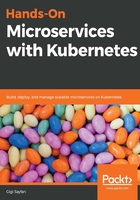
What this book covers
Chapter 1, Introduction to Kubernetes for Developers, introduces you to Kubernetes. You will receive a whirlwind tour of Kubernetes and get an idea of how well it aligns with microservices.
Chapter 2, Getting Started with Microservices, discusses various aspects, patterns, and approaches to common problems in microservice-based systems and how they compare to other common architectures, such as monoliths and large services.
Chapter 3, Delinkcious – the Sample Application, explores why we should choose Go as the programming language of Delinkcious; then we will look at Go kit.
Chapter 4, Setting Up the CI/CD Pipeline, teaches you about the problem the CI/CD pipeline solves, covers the different options for CI/CD pipelines for Kubernetes, and finally looks at building a CI/CD pipeline for Delinkcious.
Chapter 5, Configuring Microservices with Kubernetes, moves you into the practical and real-world area of microservices configuration. Also, we will discuss Kubernetes-specific options and, in particular, ConfigMaps.
Chapter 6, Securing Microservices on Kubernetes, examines how to secure your microservices on Kubernetes in depth. We will also discuss the pillars that act as the foundation of microservice security on Kubernetes.
Chapter 7, Talking to the World – APIs and Load Balancers, sees us open Delinkcious to the world and let users interact with it from outside the cluster. Also, we will add a gRPC-based news service that users can hit up to get news about other users they follow. Finally, we will add a message queue that lets services communicate in a loosely coupled manner.
Chapter 8, Working with Stateful Services, delves into the Kubernetes storage model. We will also extend the Delinkcious news service to store its data in Redis, instead of in memory.
Chapter 9, Running Serverless Tasks on Kubernetes, dives into one of the hottest trends in cloud-native systems: serverless computing (also known as Function as a Service, or FaaS). Also, we'll cover other ways to do serverless computing in Kubernetes.
Chapter 10, Testing Microservices, covers the topic of testing and its various flavors: unit testing, integration testing, and all kinds of end-to-end testing. We also delve into how Delinkcious tests are structured.
Chapter 11, Deploying Microservices, deals with two related, yet separate, themes: production deployments and development deployments.
Chapter 12, Monitoring, Logging, and Metrics, focuses on the operational side of running a large-scale distributed system on Kubernetes, as well as on how to design the system and what to take into account to ensure a top-notch operational posture.
Chapter 13, Service Mesh – Working with Istio, reviews the hot topic of service meshes and, in particular, Istio. This is exciting because service meshes are a real game changer.
Chapter 14, The Future of Microservices and Kubernetes, covers the topics of Kubernetes and microservices, and will help us learn how to decide when it's the right time to adopt and invest in newer technologies.